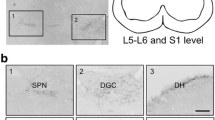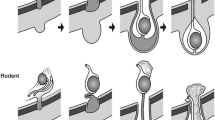Abstract
Calcitonin gene-related peptide (CGRP) released from the genitofemoral nerve (GFN) is proposed to control gubernacular migration to the scrotum during inguinoscrotal descent. As previous studies suggested that both CGRP and androgens are necessary to stimulate gubernacular elongation and proliferation, this study aimed to test whether CGRP perturbed growth of the gubernaculum by exogenous injection in a rat model of GFN blockade with an intact androgen pathway. Sprague-Dawley rats (day 0, n = 34) were injected with capsaicin (sensory neurotixin) or vehicle. CGRP (25 µl of 2 x 10 5 molar concentration) Or castor oil was administered at the umbilicus 24 h later, then every other day thereafter for 10 days. Groups of rats were sacrified on days 8 and 28, and the tip of the gubernaculunx was identified in relation to the scrotum and umbilicus. The length of the processus vaginalis (PV) was measured. In group 1 (capsaicin and CGRP), at 8 days of age (n = 8) the testes were found in the intraabdominal or suprainguinal position in 87.5% (14 testes) and the tip of the gubernaculum was oriented more laterally than normal. However the mean PV length was 5.1 mm, which was shorter than control groups (9–10.8 mm) (P < 0.001, t-test). On the other hand, at day 28, the testes were located proximal to the internal inguinal ring in 66.7% (8 testes) with their gubernacular tip oriented in part towards the umbilicus. The mean of the PV length was 12.2 mm, which was significantly decreased compared to other groups (P < 0.001, t-test). In group 2 (capsaicin and castor oil) and group 3 (vehicle and CGRP) the testes of one rat in each group at 28 days of age were located in the abdomen at the internal inguinal ring with the distal gubernacular attachment lying free and directed caudally towards the scrotum, while the rest of the testes were found in the normal location. These findings suggest that chemical interruption of sensory nerves followed by CGRP injections in rats can perturb gubernacular growth and can change the direction of migration.


Similar content being viewed by others
References
Shono T, Hutson JM (1994) Capsaicin increases the frequency of cryptorchidism in flutamide-treated rats. J Urol 152(2 Pt 2):763–765
Hutson JM (1985) A biphasic model for the hormonal control of testicular descent. Lancet 2(8452):419–421
Rosenfeld MG, Mermod JJ, Amara SG, Swanson LW, Sawchenko PE, Rivier J, Vale WW, Evans RM (1983) Production of a novel neuropeptide encoded by the calcitonin gene via tissue-specific RNA processing. Nature 304(5922):129–135
Yamanaka J, Metcalfe SA, Hutson JM (1992) Demonstration of calcitonin gene-related peptide receptors in the gubernaculum by computerized densitometry. J Pediatr Surg 27(7):876–978
Hrabovszky Z, Farmer PJ, Hutson JM (2000) Does the sensory nucleus of the genitofemoral nerve have a role in testicular descent? J Pediatr Surg 35(1):96–100
Hrabovszky Z, Naja DP, Tiffany Y, Farmer PJ, Hutson JM, Carlin JB (2002) Role of the gubernacular bulb in cremaster muscle development of the rat. Anat Rec 267(2):159–165
Clarnette TD, Hutson JM (1997) Exogenous calcitonin gene-related peptide can induce the testis to cross the scrotal septum. Br J Urol 79(4):623–627
Clarnette TD, Hutson JM (1999) Exogenous calcitonin gene-related peptide can change the direction of gubernacular migration in the mutant trans-scrotal rat. J Pediatr Surg 34(8):1208–1212
Sugita Y, Paxton GA, Hasthorpe S, Hutson JM (1997) Does calcitonin gene-related peptide act as a chemoattractant for rat gubernacular cells? J Pediatr Surg 32(1):15–17
Park WH, Hutson JM (1991) The gubernaculum shows rhythmic contractility and active movement during testicular descent. J Pediatr Surg 26(5):615–617
Shenker NS, Huynh J, Farmer PJ, Hutson JM (2006) A new role for androgen in testicular descent: permitting gubernacular cell proliferation in response to the neuropeptide, calcitonin gene-related peptide. J Pediatr Surg 41(2):407–412
Hutson JM, Hasthorpe S (2005) Testicular descent and cryptorchidism: the state of the art in 2004. J Pediatr Surg 40(2):297–302
Yamanaka J, Metcalfe SA, Hutson JM (1992) Demonstration of calcitonin gene-related peptide receptors in the gubernaculum by computerized densitometry. J Pediatr Surg 27(7):876–878
Yamanaka J, Metcalfe SA, Hutson JM, Mendelsohn FA (1993) Testicular descent. II. Ontogeny and response to denervation of calcitonin gene-related peptide receptors in neonatal rat gubernaculum. Endocrinology 132(1):280–284
Park WH, Hutson JM (1991) The gubernaculum shows rhythmic contractility and active movement during testicular descent. J Pediatr Surg 26(5):615–617
Shono T, Goh DW, Momose Y, Hutson JM (1995) Physiological effects in vitro of calcitonin gene-related peptide on gubernacular contractility with or without denervation. J Pediatr Surg 30(4):591–595
Tomiyama H, Hutson JM (2005) Contractility of rat gubernacula affected by calcitonin gene-related peptide and beta-agonist. J Pediatr Surg 40(4):683–687
Hrabovszky Z, Hutson JM (1999) Capsaicin restores gubernacular contractility in TS rats. J Pediatr Surg 34(12):1769–1772
Momose Y, Griffiths AL, Hutson JM (1992) Testicular descent. III. The neonatal mouse gubernaculum shows rhythmic contraction in organ culture in response to calcitonin gene-related peptide. Endocrinology 131(6):2881–2884
Clarnette TD, Hutson JM (1997) Exogenous calcitonin gene-related peptide can induce the testis to cross the scrotal septum. Br J Urol 79(4):623–627
Clarnette TD, Hutson JM (1999) Exogenous calcitonin gene-related peptide can change the direction of gubernacular migration in the mutant trans-scrotal rat. J Pediatr Surg 34(8):1208–1212
Griffiths AL, Middlesworth W, Goh DW, Hutson JM (1993) Exogenous calcitonin gene-related peptide causes gubernacular development in neonatal (Tfm) mice with complete androgen resistance. J Pediatr Surg 28(8):1028–1030
Abe T, Hutson JM (1994) Calcitonin gene-related peptide injected ectopically alters gubernacular migration in the flutamide treated rat with cryptorchidism. pe. su. in 9:551–554
Author information
Authors and Affiliations
Corresponding author
Rights and permissions
About this article
Cite this article
Shareef, Y.A., Sourial, M. & Hutson, J.M. Exogenous calcitonin gene-related peptide perturbs the direction and length of gubernaculum in capsaicin-treated rats. Pediatr Surg Int 23, 305–308 (2007). https://doi.org/10.1007/s00383-007-1892-z
Accepted:
Published:
Issue Date:
DOI: https://doi.org/10.1007/s00383-007-1892-z




